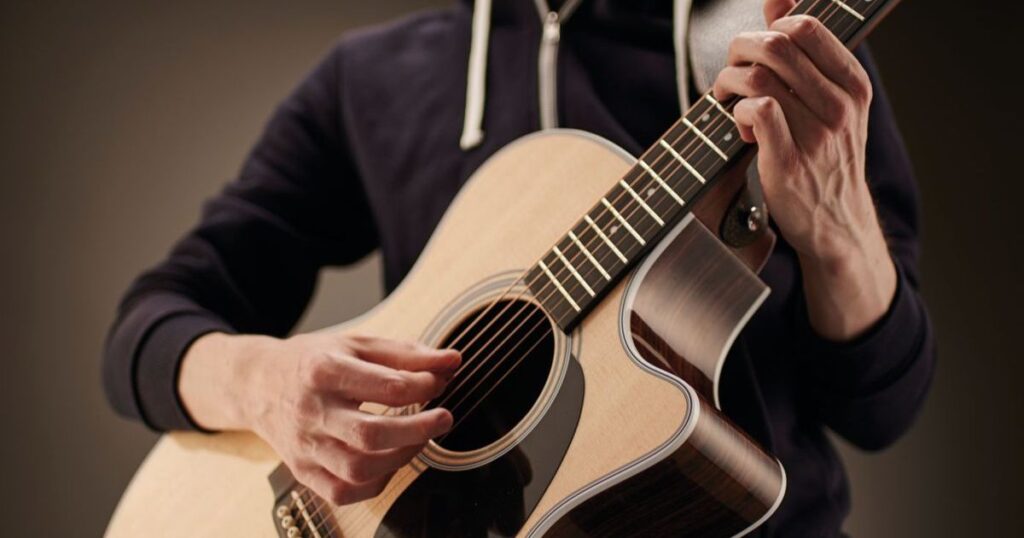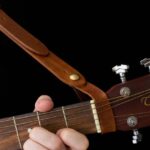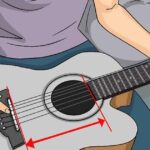Mixing acoustic guitar is the art of harmoniously blending its unique sound with other musical elements to create a polished audio recording. This process involves adjusting the guitar’s volume, tone, and applying various effects to ensure it complements the overall sound of the music, allowing it to shine while not overpowering other instruments.
The acoustic guitar, a timeless instrument, evokes images of cozy campfires, heartfelt ballads, and chart-topping hits. It carries the soul of a song, but how can you ensure it seamlessly integrates into your musical masterpiece?
To achieve that perfect blend, mastering the intricacies of mixing acoustic guitar is essential. You must grasp the fundamentals of controlling volume, fine-tuning the equalization to accentuate its character, applying reverb to add depth, and strategically panning to position it within the stereo field. These techniques will empower you to create a captivating, well-balanced sonic experience in your recordings.
Preparing Your Workspace
Before we dive into the intricacies of mixing acoustic guitar, it’s essential to set up your workspace and equipment properly. Here are the essential steps to ensure you’re off to a great start:
1. Choose the Right Room
The acoustics of the room in which you’re recording and mixing can greatly impact the final sound. Select a room that has minimal reflections and background noise. If possible, use a room with acoustic treatment, such as foam panels or diffusers, to improve the sound quality.
2. Use Quality Monitors and Headphones
Invest in a good pair of studio monitors and headphones. These are your windows into the sound you’re creating. High-quality monitoring equipment will help you make accurate decisions during the mixing process.
3. Calibrate Your Monitors
Ensure your studio monitors are calibrated to provide a flat frequency response. This calibration will help you hear the true representation of your mix, allowing for better decision-making.
4. Organize Your Session
Set up your digital audio workstation (DAW) project with dedicated tracks for your acoustic guitar recordings. Keep your project organized from the start, as this will save you time and frustration during the mixing process.
Common Acoustic Guitar Mixing Techniques
| Technique | Description |
| Choose the Right Microphone | Select the appropriate microphone type (condenser, dynamic, ribbon) for your acoustic guitar. |
| Experiment with Mic Placement | Try different positions (close-miking, mid-miking, stereo pairs) for varied tonal options. |
| Pay Attention to Room Acoustics | Select a room with minimal reflections and background noise for recording. |
| Use Quality Monitors and Headphones | Invest in high-quality studio monitors and headphones for accurate monitoring. |
| Calibrate Your Monitors | Ensure your studio monitors are calibrated for a flat frequency response. |
| Organize Your Session | Set up your DAW project with dedicated tracks for acoustic guitar recordings. |
| Edit and Comp Takes | Review recorded takes, edit, and comp together the best parts for a flawless performance. |
| Clean Up Noise and Bleed | Remove unwanted noise and bleed using noise reduction and gating plugins. |
| Time Align Multiple Microphones | Ensure proper alignment when using multiple mics to avoid phase issues. |
| Tune the Guitar | Ensure the guitar is in tune before starting the mixing process. |
| Level and Balance | Set appropriate levels and create a balanced sound by adjusting faders. |
| EQ (Equalization) | Shape the guitar’s tone by cutting unwanted frequencies and enhancing character. |
| Compression | Apply gentle compression to control dynamics and add sustain. |
| Reverb and Delay | Add depth and dimension with reverb and delay effects, adjusting the blend carefully. |
| Stereo Imaging | Enhance the stereo image through double-tracking and stereo widening plugins. |
| Tips for Specific Styles | Tailor your approach for fingerstyle, strummed, and classical acoustic guitar mixing. |
| A/B Testing | Compare your mix to references to ensure it meets professional standards. |
| Check for Phase Issues | Listen for phase cancellation problems and adjust phase alignment if necessary. |
| Automation | Use automation to ride the faders and enhance dynamics throughout the song. |
| Listen on Different Systems | Test the mix on various playback systems to ensure it translates well. |
| Seek Feedback | Get input from others to gain valuable insights and suggestions for improvement. |
Recording Acoustic Guitar
To effectively mix acoustic guitar, you need high-quality recordings as your starting point. Here are some tips on recording acoustic guitar to ensure you have the best raw material for mixing:
1. Choose the Right Microphone
Selecting the appropriate microphone for your acoustic guitar can significantly impact the tone you capture. Consider these options:
Condenser Microphones
Condenser microphones are a popular choice for capturing the rich, detailed sound of acoustic guitars. They are sensitive and can reproduce the nuances of the instrument effectively.
Dynamic Microphones
Dynamic microphones are more rugged and can handle high sound pressure levels. While not as detailed as condenser mics, they can be a good choice for close-miking acoustic guitars.
Ribbon Microphones
Ribbon microphones offer a vintage and smooth sound. They are ideal for capturing the warmth of acoustic guitars.
2. Experiment with Mic Placement
The placement of the microphone relative to the guitar is critical. Try different positions, such as:
- Close-Miking: Placing the microphone close to the soundhole or the 12th fret can emphasize the low end and body of the guitar.
- Mid-Miking: Positioning the microphone around 12 to 24 inches away from the guitar’s body can capture a balanced sound with natural room reflections.
- Stereo Pair: Using a stereo pair of microphones (e.g., XY or ORTF) can create a wide and immersive stereo image.
3. Pay Attention to Room Acoustics
The room’s acoustics play a significant role in the recorded sound. Experiment with the microphone placement to find the sweet spot that minimizes unwanted reflections and resonances.
4. Use a Pop Filter
A pop filter can help reduce plosive sounds and excessive air noise, ensuring cleaner recordings.
5. Monitor While Recording
While tracking, pay attention to the headphone mix. Ensure that the guitarist can hear themselves clearly and that the microphone placement captures the desired sound.
Preparing Your Acoustic Guitar Tracks

Once you have recorded your acoustic guitar tracks, it’s time to prepare them for the mixing process. Here are some essential steps to follow:
- Edit and Comp Takes: Review your recorded takes and edit them as necessary. Comp together the best parts of each take to create a flawless performance.
- Clean Up Noise and Bleed: Remove any unwanted noise, such as background hiss or hum, and address any bleed from other instruments. Noise reduction and gating plugins can be helpful in this regard.
- Time Align Multiple Microphones: If you used multiple microphones to capture the guitar, make sure they are time-aligned to avoid phase issues. This is especially important for stereo miking techniques.
- Tune the Guitar: Before diving into the mixing process, ensure that the guitar is in tune. Out-of-tune recordings can be challenging to work with during mixing.
Mixing Acoustic Guitar: Step-by-Step
Now that you have your well-recorded guitar tracks, it’s time to dive into the mixing process. Follow these steps to create a balanced and polished acoustic guitar sound:
1. Level and Balance
Achieving the right balance is the foundation of a good mix. Start by setting the levels of your guitar tracks. Here’s how:
Solo Each Track
Listen to each acoustic guitar track in isolation. This will help you identify any issues or artifacts that need to be addressed.
Set the Faders
Gradually bring up the faders for each track while listening to how they interact. Aim for a balanced sound where no one track dominates.
Use Panning
Experiment with panning to create a sense of space. For example, pan one track slightly to the left and the other slightly to the right for a wider stereo image.
2. EQ (Equalization)
EQ is a powerful tool for shaping the tone of your acoustic guitar tracks. Here’s how to approach it:
Cut Unwanted Frequencies
Use a high-pass filter to remove low-frequency rumble and mud. This will clean up the sound and make room for other instruments.
Enhance the Character
Boost frequencies in the guitar that bring out its unique character. For example, a gentle boost in the midrange can add warmth, while a high-frequency boost can bring out sparkle.
Address Problem Frequencies
Listen for any frequencies that sound harsh or unpleasant and use a narrow EQ band to reduce them. Common trouble spots are around 2-4 kHz.
3. Compression
Compression can help control the dynamic range of your guitar tracks and add sustain. Follow these steps:
Use a Light Touch
Apply gentle compression with a low ratio (2:1 to 4:1) to maintain a natural sound. Avoid excessive compression that can squash the dynamics.
Adjust Attack and Release
Set the attack time to allow the initial transients of the guitar to pass through. A longer release time can create a smooth, natural sustain.
Parallel Compression
Consider using parallel compression to retain the dynamics of the original signal while adding a controlled compressed version to give the guitar more presence.
4. Reverb and Delay
Reverb and delay can add depth and dimension to your acoustic guitar sound. Here’s how to use them effectively:
Choose the Right Reverb
Select a reverb with a decay time that suits the style of your music. Shorter decay times work well for intimate and dry sounds, while longer decay times are suitable for spacious arrangements.
Send Levels
Create auxiliary or “send” tracks for your reverb and delay effects. Send a portion of each acoustic guitar track to these effects to control the wet/dry balance.
Adjust the Blend
Experiment with the blend of dry and wet signals to find the right amount of reverb or delay for your mix. Be subtle, as it’s easy to overdo it.
5. Stereo Imaging
Enhance the stereo image of your acoustic guitar to create a wider and more immersive sound:
- Double-Tracking: Consider double-tracking the guitar by re-recording the part to create a natural stereo image.
- Widening Plugins: Use stereo widening plugins to add width to your guitar tracks. Be cautious not to make the sound too wide, as it can lead to phase issues.
Tips for Mixing Specific Acoustic Guitar Styles
Different styles of acoustic guitar playing require unique mixing approaches. Here are some tips for specific genres:
1. Fingerstyle Acoustic
Fingerstyle acoustic guitar is known for its intricate picking patterns and delicate nuances. To mix fingerstyle acoustic guitar effectively:
a. Emphasize Clarity
Use EQ to bring out the clarity in the fingerpicked notes. A gentle boost in the midrange can make the notes stand out.
b. Subtle Reverb
Apply a subtle reverb to add a sense of space without overpowering the delicate nature of fingerstyle playing.
2. Strummed Acoustic
Strummed acoustic guitar provides a rhythmic foundation for many songs. To mix strummed acoustic guitar effectively:
Focus on the Midrange: Boost the midrange frequencies to make the strumming patterns more prominent in the mix.
Controlled Dynamics: Use compression to control the dynamic range of strummed chords while keeping the performance energetic.
3. Classical Acoustic
Classical acoustic guitars have a unique tone characterized by their nylon strings and warm resonance. To mix classical acoustic guitar effectively:
- Embrace the Warmth: Enhance the warm and rich qualities of classical guitar by boosting the low end and using a longer reverb.
- Minimal Effects: Keep the effects minimal to preserve the purity of the classical guitar sound. A touch of reverb and gentle EQ adjustments are usually sufficient.
Finalizing Your Mix
Once you’ve applied the necessary processing and adjustments, it’s time to finalize the action on an acoustic guitar mix. Here are some additional steps to ensure a polished result:
- A/B Testing: Compare your mix to reference tracks or alternate mixes to ensure it stands up to professional standards.
- Check for Phase Issues: Listen for phase cancellation problems, especially if you used multiple microphones. Adjust the phase alignment if needed.
- Automation: Use automation to ride the faders and make subtle level adjustments throughout the song. This can enhance the overall dynamics.
- Listen on Different Systems: Test your mix on various playback systems, such as headphones, studio monitors, and car speakers, to ensure it translates well across different platforms.
- Seek Feedback: Don’t hesitate to seek feedback from other producers or musicians. Fresh ears can provide valuable insights and suggestions for improvement.
FAQs
What is mixing an acoustic guitar?
Mixing an acoustic guitar means adjusting its sound to fit well within a song. It involves changing volume, tone, and effects to make it sound good with other instruments.
Why is mixing important for an acoustic guitar?
Mixing is crucial because it helps the guitar blend nicely with other music. It ensures the guitar sounds clear but doesn’t overpower other instruments.
What do I need to mix an acoustic guitar?
You’ll need to understand volume, EQ, reverb, and panning. This knowledge helps create a balanced sound when mixing the acoustic guitar into a song.
Conclusion
Mastering the art of mixing acoustic guitar is an essential skill for anyone looking to create professional and captivating music. It’s the process of harmonizing the rich and soulful tones of the acoustic guitar with other instruments to produce a harmonious sound. By adjusting volume, equalization (EQ), reverb, and panning, you can make sure the guitar complements the overall composition without overpowering it.
Effective mixing can transform a simple guitar riff into a harmonious symphony, enhancing the emotional impact of your music. It allows the acoustic guitar to shine and convey its unique character within the song. Whether you’re a budding musician or an experienced producer, understanding the nuances of mixing acoustic guitar is a valuable skill that can take your music to the next level. With patience and practice, you can create beautiful recordings that capture the essence of the acoustic guitar and make your music truly unforgettable. So, dive into the world of acoustic guitar mixing, and let your musical creativity flourish.




